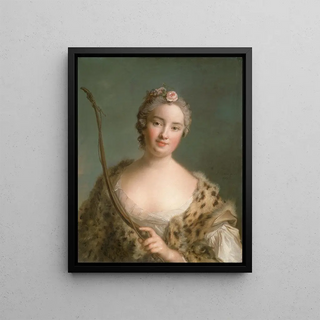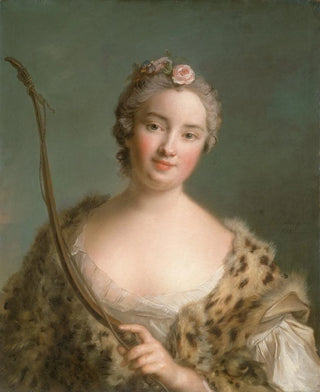Art print | Charlotta Fredrika Sparre 1719-1795 later Countess Fersen - Jean-Marc Nattier


View from behind

Frame (optional)
Charlotta Fredrika Sparre 1719-1795, later Countess Fersen - Jean-Marc Nattier – Engaging Introduction
Jean-Marc Nattier's painting, "Charlotta Fredrika Sparre 1719-1795, later Countess Fersen," is a captivating work that embodies the elegance and refinement of the 18th century. This portrait, created in 1750, transports us into a universe where beauty and nobility blend harmoniously. Through the gaze of Countess Fersen, Nattier invites us to explore not only the personality of his model but also the social and cultural context of her time. The delicacy of the features, the choice of colors, and the graceful posture of the countess immerse us in a world where art aims to be both a mirror of reality and a reflection of aristocratic aspirations.
Style and uniqueness of the work
Nattier stands out for his ability to capture the very essence of his subjects, and this portrait is a perfect example. The soft light illuminating Charlotta Fredrika Sparre's face highlights her natural beauty while emphasizing the richness of the details in her attire. The choice of fabrics, delicate ornaments, and pastel color palette demonstrate a keen sense of aesthetics. The countess's posture, slightly turned to the right, evokes both grace and dignity, characteristic of aristocratic portraits of this period. The artist also plays with decorative elements, incorporating floral motifs and drapes that envelop the subject in an atmosphere of serenity and sophistication. This work is not limited to a simple portrait; it is a representation of female identity within high society in the 18th century, where every detail is carefully designed to convey a message of nobility and prestige.
The artist and his influence
Jean-Marc Nattier, born in 1685, is one of the most emblematic portraitists of his time. Trained at the Royal Academy of Painting and Sculpture, he established himself thanks to his exceptional talent and deep understanding of the social codes of his era. His work is marked by an innovative approach that combines traditional portraiture with elements of mythology and allegory. Nattier has

Matte finish

View from behind

Frame (optional)
Charlotta Fredrika Sparre 1719-1795, later Countess Fersen - Jean-Marc Nattier – Engaging Introduction
Jean-Marc Nattier's painting, "Charlotta Fredrika Sparre 1719-1795, later Countess Fersen," is a captivating work that embodies the elegance and refinement of the 18th century. This portrait, created in 1750, transports us into a universe where beauty and nobility blend harmoniously. Through the gaze of Countess Fersen, Nattier invites us to explore not only the personality of his model but also the social and cultural context of her time. The delicacy of the features, the choice of colors, and the graceful posture of the countess immerse us in a world where art aims to be both a mirror of reality and a reflection of aristocratic aspirations.
Style and uniqueness of the work
Nattier stands out for his ability to capture the very essence of his subjects, and this portrait is a perfect example. The soft light illuminating Charlotta Fredrika Sparre's face highlights her natural beauty while emphasizing the richness of the details in her attire. The choice of fabrics, delicate ornaments, and pastel color palette demonstrate a keen sense of aesthetics. The countess's posture, slightly turned to the right, evokes both grace and dignity, characteristic of aristocratic portraits of this period. The artist also plays with decorative elements, incorporating floral motifs and drapes that envelop the subject in an atmosphere of serenity and sophistication. This work is not limited to a simple portrait; it is a representation of female identity within high society in the 18th century, where every detail is carefully designed to convey a message of nobility and prestige.
The artist and his influence
Jean-Marc Nattier, born in 1685, is one of the most emblematic portraitists of his time. Trained at the Royal Academy of Painting and Sculpture, he established himself thanks to his exceptional talent and deep understanding of the social codes of his era. His work is marked by an innovative approach that combines traditional portraiture with elements of mythology and allegory. Nattier has






